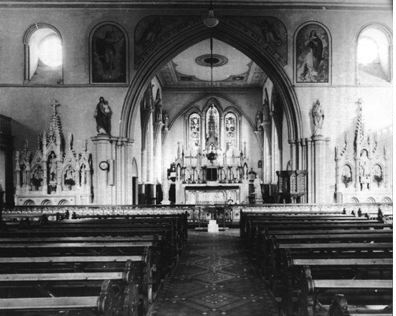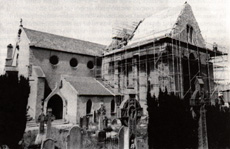

Duiske Abbey, Graignamanagh was a Cistercian Monastery situated where a small steam, the Black Water (Dubh Uisce), flows into the right bank of the River Barrow. It is at the junction of the roads from Goresbridge (8 miles), Borris (5 miles), New Ross (11 miles), Inistiogue (5 miles), and Thomastown (9 miles). This is an abbey in which there has been continuity of worship for over 750 years. It is a well documented abbey, and fortunately its charters and legal documents have survived. As early as 1180 an Irish Chief, Dermot O'Riain wished to build an abbey here for 'God, Saint Mary and Saint Benedict', in other words, a Benedictine Abbey. However, this was not to be. In 1166 the Normans, led by Strongbow, conquered Leinster and became landlords. William, the Earl Marshall, was the second richest man in England and he was a great benefactor of the Cistercian Order there. He was particularly generous to Stanley Abbey, Wiltshire, and when he died, Stanley Abbey had a special intercessory Mass and a processional chant in the Abbey for the repose of his soul. William was anxious to build a monastery in Ireland. His friend Philip de Prendergast knew about this desire and told him of the abbey site that had never been built upon. William asked the General Chapter of the Cistercian Order if they would grant him a favour by allowing him to build a Cistercian Abbey on this site in Ireland. The Cistercian Order required that any site chosen for an abbey needed to have certain amenities and decided to inspect it. Accordingly, the matter was raised at a meeting of the General Chapter of the Order and the Abbots of Mellifont and Dublin were told to make enquiries about the site and report back to the General Chapter. These two Abbots passed the work of inspection on to the Abbots of Kilcooley and Jerpoint. However, the latter did not inspect the site and when the matter was raised at the meeting of the General Chapter the following year, they were punished for their remissness. They had to stand outside their abbatial stalls for one out of three days for a year.
 In the meantime the Earl Marshall
approached the Abbot of Stanley to send an abbot and twelve
monks. This was before the final approval of the General Chapter,
an act contrary to Cistercian Rules for which he was deposed,
although he was made Abbot of Buckfast, Devon the following year.
The Cistercians are primarily agriculturists and their first
necessity was to look for some farming area, which would support
their bodily needs and provide a surplus to sustain those who
would actually build the monastery. In due course they found a
suitable farm for such an enterprise at Annamult, 1,350 acres of
good quality soil situated on the right bank of the River Nore.
This was where they developed their first farm and accommodation.
Some time later, another 2,000 acre farm was given to them, in
those days called Tullaghanny, now called Cuffes Grange near
l)anesfort, County Kilkenny. This they also developed as a farm
with residence and chapel. From both these areas they also
recruited and trained many young men as monks and lay brothers.
In the meantime the Earl Marshall
approached the Abbot of Stanley to send an abbot and twelve
monks. This was before the final approval of the General Chapter,
an act contrary to Cistercian Rules for which he was deposed,
although he was made Abbot of Buckfast, Devon the following year.
The Cistercians are primarily agriculturists and their first
necessity was to look for some farming area, which would support
their bodily needs and provide a surplus to sustain those who
would actually build the monastery. In due course they found a
suitable farm for such an enterprise at Annamult, 1,350 acres of
good quality soil situated on the right bank of the River Nore.
This was where they developed their first farm and accommodation.
Some time later, another 2,000 acre farm was given to them, in
those days called Tullaghanny, now called Cuffes Grange near
l)anesfort, County Kilkenny. This they also developed as a farm
with residence and chapel. From both these areas they also
recruited and trained many young men as monks and lay brothers.
Neither of those two sites were destined for abbey sites. The site for the abbey was Bun Dubhuisce, and in 1204 after a wooden cross was erected, the first tree was felled and the first sod was cut to excavate the site for Saint Saviour's Cistercian Abbey, Graignamanagh. The team of monks who built the abbey lived one mile west of the present site, where some monks also farmed. This was at Old Grange. Here McMurrough had begun to build a church but it was never finished, so the monks roofed it over and erected more farm buildings to accommodate their needs. These three centres were the economic units from which Duiske Abbey rose and because of their farming enterprises, they were called Granges. Crange comes from the Latin word 'Grangii' meaning barn, hence they had Annamult Grange, Cuffes Grange (also called Grange Castri) and Old Grange.
Copyright (C) Flame Industries 1998-2002. No Unauhtorised Copying or Reproducing of any material on this website, without the Authors Prior Notice and Approval. International Copyright Laws Apply.